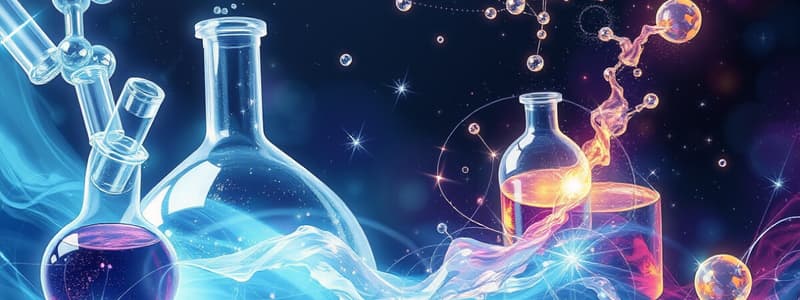Podcast
Questions and Answers
What percentage of the human body weight is primarily composed of carbon, hydrogen, oxygen, and nitrogen?
What percentage of the human body weight is primarily composed of carbon, hydrogen, oxygen, and nitrogen?
- 75%
- 100%
- 88%
- 96% (correct)
Which of these elements is NOT considered a trace element essential for human life?
Which of these elements is NOT considered a trace element essential for human life?
- Calcium (correct)
- Magnesium
- Iodine
- Iron
What kind of substances do compounds consist of?
What kind of substances do compounds consist of?
- Elements that can be broken down chemically
- Two or more elements in fixed proportion (correct)
- One element in fixed proportion
- Only trace elements
What is the main reason for the iodization of table salt in many countries?
What is the main reason for the iodization of table salt in many countries?
Which of the following correctly describes trace elements?
Which of the following correctly describes trace elements?
What is the atomic number of carbon?
What is the atomic number of carbon?
Which of the following elements would contain an equal number of protons and electrons in a neutral state?
Which of the following elements would contain an equal number of protons and electrons in a neutral state?
Which statement correctly defines an isotope?
Which statement correctly defines an isotope?
What does the mass number of an atom represent?
What does the mass number of an atom represent?
What role do electrons play in an atom?
What role do electrons play in an atom?
Flashcards are hidden until you start studying
Study Notes
Chemical Composition of Living Organisms
- Living organisms are made up of matter, defined as anything that occupies space and has mass.
- Matter consists of elements, which are pure substances that cannot be broken down chemically; 92 elements are found in nature.
- Essential elements for human life total 25, with 96% of body weight attributed to carbon, hydrogen, oxygen, and nitrogen, key for sugars, fats, proteins, and nucleic acids.
- Remaining 4% of body weight includes calcium, magnesium, chlorine, sodium, potassium, phosphorus, and sulfur.
- Trace elements, such as iron (0.004% of body mass) for hemoglobin, and iodine (0.15mg daily), are crucial for life.
Compounds
- Compounds are formations of two or more elements in fixed proportions, exhibiting different properties from their constituent elements.
- Sodium chloride (NaCl) and water (H2O) are common examples of compounds.
- Organism compounds primarily contain carbon, oxygen, nitrogen, and hydrogen; different arrangements provide unique characteristics.
Atoms
- Atoms are the smallest units of matter retaining elements’ properties, made of protons, neutrons, and electrons.
- Protons (positive charge) and neutrons (neutral charge) are in the nucleus; electrons (negative charge) orbit the nucleus.
- Atomic number = number of protons; mass number = sum of protons and neutrons.
Isotopes
- Isotopes are variants of elements with the same number of protons but different neutron counts, affecting mass but not chemical properties.
- Carbon has three isotopes, with Carbon-12 being the most abundant.
Electron Arrangement of an Atom
- Electrons influence an atom's chemical reactivity, with energy levels corresponding to varying distances from the nucleus.
- Outer electron shells typically hold 8 electrons; fewer indicate reactivity, leading to ionic or covalent bonds to achieve stability.
Ionic Bonds
- Atoms with one electron in their outer shell tend to donate it, while those needing one will accept it, forming ionic bonds (example: NaCl).
- Sodium donates an electron to chlorine, creating charged ions (Na+ and Cl-) that attract due to opposite charges.
Covalent Bonds
- Formed when atoms share electrons; examples include molecular hydrogen (H2) and oxygen (O2).
- The number of covalent bonds depends on how many electrons fill an atom's outer shell.
Unequal Electron Sharing
- Electronegativity measures an atom's attraction for electrons; unequal sharing leads to polar covalent bonds (e.g., H2O).
- Electrons are shared equally in non-polar covalent bonds.
Hydrogen Bonds
- Weaker, non-covalent bonds that form between molecules, important for cellular functions.
- Hydrogen, part of a polar covalent bond, carries a partial positive charge and interacts with negatively charged atoms in adjacent molecules.
Hydrogen Bonds and Temperature
- Heat, related to molecular movement, is needed to break hydrogen bonds, impacting water temperatures.
- Water cools as hydrogen bonds reform, slowing molecular speed and lowering temperature.
Evaporation
- Evaporation moderates temperature by allowing hot (high-energy) molecules to escape, leaving behind cooler liquid (e.g., sweating).
Hydrogen Bonds and Density
- Water has unique density properties: ice is less dense than liquid water due to stable hydrogen bonds forming a crystal structure.
- In liquid water, hydrogen bonds continuously break and reform, affecting its density.
Water as a Solvent
- A solution is a uniform mixture of substances, with water acting as a solvent, dissolved substances called solutes (e.g., sugar, salt).
- Water's polarity allows it to dissociate ionic compounds (NaCl), surrounding ions with water molecules.
pH Scale
- Measured from 0 to 14; 7 is neutral where H+ equals OH- concentration.
- pH levels below 7 are acidic, while levels above 7 are basic, affecting chemical behavior and reactions within living organisms.
Studying That Suits You
Use AI to generate personalized quizzes and flashcards to suit your learning preferences.




